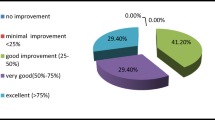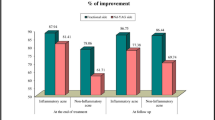Abstract
Cutaneous leishmaniasis is an endemic disease in Iran. Unfortunately, it can lead to unsightly atrophic scars with limited treatment options. Fractional CO2 laser is accepted for treatment of atrophic acne scars and recently has been used to treat cutaneous leishmaniasis, so we planned to use fractional CO2 laser on leishmaniasis scar. We conducted this study on 60 leishmaniasis scars on the face of 40 patients. The lesions were treated by a fractional CO2 laser with beam size of 120 μm, with energy of 50–90 mJ, and 50–100 spots/cm2 density with two passes in three monthly sessions. Evaluation was done in the first and second months after the first treatment and 3 and 6 months after the last treatment. Digital photography was performed at each visit. Assessment of improvement rate by patient and physician was rated separately as follows: no improvement (0 %), mild (<25 %), moderate (25–50 %), good (51–75 %), and excellent (76–100 %). Based on patients’ opinion, in the first and second follow-up, 48.3 and 90 % of them reported moderate to excellent healing, respectively (p < 0.001). In 3 and 6 months follow-up after the end of the experiment, most of the patients (88.3 and 95 %, respectively) reported moderate to excellent healing of scars. Based on two observers’ opinion, healing in the first follow-up in most of the patients (65 %) was mild to moderate and 33 % were reported as having no healing. In the second follow-up, only 5 % of the patients were reported with no healing and 60 % were reported as having moderate healing (p < 0.001). In 3 and 6 months follow-up, most of the patients (95 and 96.6 %) were reported as having moderate to excellent healing (p = <0.001). Our results underlined the high efficacy of fractional CO2 laser for leishmaniasis scar. No significant adverse effects were noted.

Similar content being viewed by others
References
Nadim A, Tahvildari BG (1977) Epidemiology of cutaneous leishmaniasis in Iran: B. Khorassan. Part VI: cutaneous leishmaniasis in Neishabur, Iran. Bull Soc Pathol Exot Filiales 70:171–177
Weigel MM, Armijos RX (2001) The traditional and conventional medical treatment of cutaneous leishmaniasis in rural Ecuador. Rev Panam Salud Públ Pan Am J Publ health 10:395–404
Reithinger R, Aadil K, Kolaczinski J, Mohsen M, Hami S (2005) Social impact of leishmaniasis, Afghanistan. Emerg Infect Dis 11:634–636
Nilforoushzadeh MA, Jaffary F, Ansari N, Moradi S, Siadat AH (2011) The comparison between trichloroacetic acid 50% and CO 2 laser in the treatment of cutaneous leishmaniasis scar. Indian J Dermatol 56:171–173
Zachary CB, Rofagha R (2012) Laser therapy. In: Bolognia JL, Jorizzo JL, Schaffer JV (eds) Dermatology, 3rd edn. Mosby, Spain, pp 2271–2275
Alghamdi KM (2010) Successful treatment of atrophic scars from cutaneous leishmaniasis using a fractional laser. J Cutan Med Surg 14:303–306
Alster TS, West TB (1997) Treatment of scars: a review. Ann Plast Surg 39:418–432
Alster TS, Tanzi EL (2003) Hypertrophic scars and keloids: etiology and management. Am J Clin Dermatol 4:235–243
Alster TS, Lupton JR (2002) Prevention and treatment of side effects and complications of cutaneous laser resurfacing. Plast Reconstr Surg 109:308–316
Lupton JR, Alster TS (2002) Laser scar revision. Dermatol Clin 20:55–65
Il G, Alster TS (2000) Laser revision of scars and striae. Dermatol Ther 13:50–59
Bernstein LJ, Kauvar AN, Grossman MC, Geronemus RG (1998) Scar resurfacing with high-energy, short-pulsed and flashscanning carbon dioxide lasers. Dermatol Surg 24:101–107
Alster TS (1999) Cutaneous resurfacing with CO2 and erbium: YAG lasers: preoperative, intraoperative, and postoperative considerations. Plast Reconstr Surg 103:619–632
Tanzi EL, Alster TS (2002) Treatment of atrophic facial acne scars with a dual-mode Er:YAG laser. Dermatol Surg 28:551–555
Altshuler GB, Anderson RR, Manstein D, Zenzie HH, Smirnov MZ (2001) Extended theory of selective photothermolysis. Lasers Surg Med 29:416–432
Alster TS, Kauvar AN, Geronemus RG (1996) Histology of high-energy pulsed CO2 laser resurfacing. Semin Cutan Med Surg 15:189–193
Fitzpatrick RE, Tope WD, Goldman MP, Satur NM (1996) Pulsed carbon dioxide laser, trichloroacetic acid, Baker-Gordon phenol, and dermabrasion: a comparative clinical and histologic study of cutaneous resurfacing in a porcine model. Arch Dermatol 132:469–471
Alster TS, Konda S (2007) Plasma skin resurfacing for regeneration of neck, chest, and hands: investigation of a novel device. Dermatol Surg 33:1315–1321
Kye YC (1997) Resurfacing of pitted facial scars with a pulsed Er:YAG laser. Dermatol Surg 23:880–883
Kutlubay Z, Gokdemir G (2010) Treatment of atrophic facial acne scars with the Er:YAG laser: a Turkish experience. J Cosmet Laser Ther 12:65–72
Cho SI, Kim YC (1999) Treatment of atrophic facial scars with combined use of high-energy pulsed CO2 laser and Er:YAG laser: a practical guide of the laser techniques for the Er:YAG laser. Dermatol Surg 25:959–964
Alajlan AM, Alsuwaidan SN (2011) Acne scars in ethnic skin treated with both non-ablative fractional 1,550 nm and ablative fractional CO2 lasers: comparative retrospective analysis with recommended guidelines. Lasers Surg Med 43:787–791
Brown P, Miller ME, Bandino J, Hivnor C (2012) Laser treatment of scars and keloids. Cosmet Dermatol 25:318–325
Walgrave SE, Ortiz AE, MacFalls HT, Elkeeb L, Truitt AK, Tournas JA, Zelickson BD, Zachary CB (2009) Evaluation of a novel fractional resurfacing device for treatment of acne scarring. Lasers Surg Med 41(2):122–7
Bak H, Kim BJ, Lee WJ, Bang JS, Lee SY, Choi JH, Chang SE (2009) Treatment of striae distensae with fractional photothermolysis. Dermatol Surg 35(8):1215–20
Chapas AM, Brightman L, Sukal S, Hale E, Daniel D, Bernstein LJ, Geronemus RG (2008) Successful treatment of acneiform scarring with CO2 ablative fractional resurfacing. Lasers Surg Med 40:381–6
Ong MW, Bashir SJ (2012) Fractional laser resurfacing for acne scars: a review. Br J Dermatol 166:1160–1169
Ramsdell WM (2012) Fractional CO2 laser resurfacing complications. Semin Plast Surg 26:137–40
Metelitsa AI, Alster TS (2010) Fractionated laser skin resurfacing treatment complications: a review. Dermatol Surg 36:299–306
Acknowledgments
The authors express their profound gratitude to the research deputy of Mashhad University of Medical Sciences for the financial support and approval of the research proposal related to the thesis of Hamid Reza Moghimi. We also appreciate the cooperation of staff in Simateb laser clinic.
Author information
Authors and Affiliations
Corresponding author
Ethics declarations
Conflict of interest
The authors declare that they have no competing interests.
Rights and permissions
About this article
Cite this article
Banihashemi, M., Nahidi, Y., Maleki, M. et al. Efficacy of fractional CO2 laser in treatment of atrophic scar of cutaneous leishmaniasis. Lasers Med Sci 31, 733–739 (2016). https://doi.org/10.1007/s10103-016-1919-6
Received:
Accepted:
Published:
Issue Date:
DOI: https://doi.org/10.1007/s10103-016-1919-6




